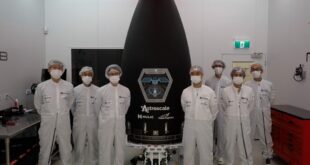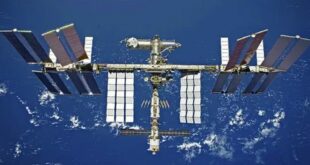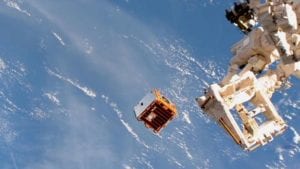
By Helen Jameson
Humanity is really finding itself in a mess.
We haven’t looked after our planet, and, in the grand scheme of things, it’s all happened very quickly. The Industrial Revolution may have made life easier for us, but it’s had a devastating impacting on our home. We’re on a course of self-destruction with plastic, chemicals, vehicles and other pollutants choking the air we breathe and our oceans. Are we learning from it? It seems not, because, since the first days of our foray into space, we have started to pollute that too.
Zombie satellites, spent rocket stages, paint flecks, nuts and bolts – you name it, they are already circling our Earth in what are becoming crowded orbits and they are traveling fast, so fast that they have the potential to do great damage.
All of these objects pose a threat to operational spacecraft and the space environment. As we talk about the prospect of doing more in space: launching mega constellations of small satellites into LEO, asteroid mining, building a Moon Village, we need to focus on how we clean up the mess that we have already created. How can we expect to do more in space when we are not cleaning up after ourselves or if we don’t even know what’s up there and what risks it could pose.
Technology takes a long time to develop and bring into operation – that is true. But we have been aware of the debris problem in orbit for many, many years and yet it seems that we are still in virtually the same position we were ten years ago, but is this really the case? There’s no quick fix and it’s an extremely complex problem to solve, but are we doing enough to rid our orbits of the junk?
Crater Impacts on Colombus Module
Evidence of space debris is increasing and for anyone who doubts this, the Colombus module provides proof. European scientists initiated the Colombus Crater Survey, which was carried out in September 2018. The Module, part of the International Space Station (ISS), has been in orbit for the past decade. Scientists wanted to survey the in-orbit laboratory for signs of impact damage from either space debris or rock. A robotic arm equipped with a camera, completed two scans of the outer panels of the module in search of craters and the results were significant.
Initial analysis of the data revealed that there were several hundred craters which the team determined had been left by very small pieces of natural or manmade debris. They estimated that these items would have been less than 1mm in size. It certainly gives a good idea of what could happen if a larger object were to collide with either the ISS or an operational satellite and highlights the importance of knowing what is up there in terms of being able to protect astronauts and functional satellites in our orbits.
There are companies, individuals and institutions that are working hard to combat space junk and the threats that it poses. I want to look briefly at two projects that could help to tackle the challenge.
RemoveDEBRIS
The first is RemoveDEBRIS and it aims to perform technology demonstrations that could find the best way to start the removal of the 40,000 items of space junk circling the Earth. RemoveDEBRIS is a project funded by the European Commission, amongst others, and that is led by the Surrey Space Centre. The satellite and cubesats have been built by a consortium of space companies. The project deployed its first mission from the ISS in September last year.
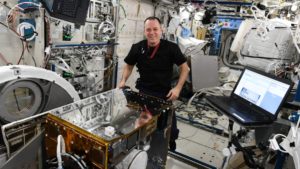
The RemoveDEBRIS mission comprised of a 100kg satellite that was transported to the ISS on the SpaceX Dragon spacecraft last April. The satellite was then deployed from the Kibo Module using the Canadarm-2 on 20 June and then on 16 September, it demonstrated its ability to use a net to capture a deployed simulated target, in this case, a cubesat.
In October 2018, the spacecraft took images of the cubesat descending into space using its LiDAR and colour camera in order to give accurate information that could measure the distance, direction and speed of debris. The entire mission should last approximately 1.5 years at which point the satellite will burn up in the Earth’s atmosphere.
The test will give the team much more information about the behaviour of space debris and the way it moves in space. This kind of knowledge is crucial in terms of executing Active Debris Removal (ADR).
Astroscale
With so many new smallsats set to be launched, Singpore-based company Astroscale is focusing on the removal of satellites once they have reached the end of their operational life.
Their demonstration satellite, ELSA-d, will capture the satellites and then pull them down into the atmosphere where both satellites will be burned up and will be able to deal with debris with a mass of up to 500kg. The company is talking about teaming up with small satellite operators looking to deploy satellites in LEO, and attaching a magnetic plate to the exterior of the spacecraft onto which the Astroscale satellite can attach using a magnetic robotic arm, guiding the dead spacecraft and itself to burn up in the atmosphere. At present, the spacecraft would be lost each time a removal manoeuvre happens, but the ideal scenario would be to have a reusable spacecraft that could carry out multiple disposals. However, developments in re-fuelling technology or in spacecraft propulsion could see this happen in the future.
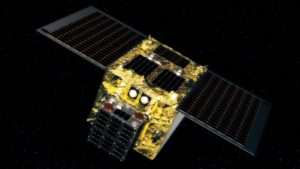
Astroscale’s ELSA-d demonstration mission is slated for launch this year. Like RemoveDEBRIS, it will launch a dummy satellite to be retrieved by its technology. If the demonstration is successful, the company is hopeful that it will begin production of the satellites on a large scale by 2020.
Both RemoveDEBRIS and Astroscale are just two examples of the ways in which companies and institutions are trying to find ways in which to begin to tackle the space debris problem.
There are several other companies that are engaged in researching and developing ways and means in which debris can be tackled. Others are looking to extend the life of satellites so that, instead of being de-orbited and left in the satellite ‘graveyard’, they are re-invigorated and re-fueled and remain operational for a much longer period of time.
These are all great initiatives and innovate in their approach but we really do need to hope that at least some will become operational soon because we need them – yesterday. The trouble is this this is all new, it’s very expensive and it takes a long time to come to fruition. Let’s hope the early 2020s see an acceleration in the availability of the technology.
Since we began our first steps into space, the issue of space debris has always been there. However, this is now about to be magnified many, many times over due to the promise of huge amounts of smallsats being deployed into LEO. Surely a lot of the responsibility for space debris has to be placed on the shoulders of operators. There are a lot of concerns about how they will deal with such a huge number of satellite being deployed. Operators promise that used satellites will deorbit and burn up, but this all remains to be seen.
In terms of space debris, though we have been active in space since 1957, when Sputnik became the very first manmade object in space, it seems that we haven’t given this subject enough thought or time. And, like the Earth, if dramatic progress is not made soon, we will pollute the space environment as we have done our planet and we may well jeapordise our plans for human expansion into space.
Helen Jameson is the Editor-in-Chief of SpaceWatch.Global.
 SpaceWatch.Global An independent perspective on space
SpaceWatch.Global An independent perspective on space


